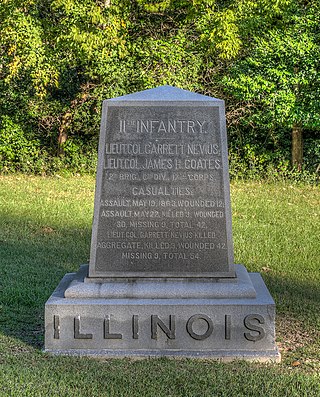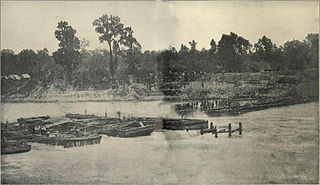
United States Colored Troops (USCT) were Union Army regiments during the American Civil War that primarily comprised African Americans, with soldiers from other ethnic groups also serving in USCT units. Established in response to a demand for more units from Union Army commanders, USCT regiments, which numbered 175 in total by the end of the war in 1865, constituted about one-tenth of the manpower of the army, according to historian Kelly Mezurek, author of For Their Own Cause: The 27th United States Colored Troops. "They served in infantry, artillery, and cavalry." Approximately 20 percent of USCT soldiers were killed in action or died of disease and other causes, a rate about 35 percent higher than that of white Union troops. Numerous USCT soldiers fought with distinction, with 16 receiving the Medal of Honor. The USCT regiments were precursors to the Buffalo Soldier units which fought in the American Indian Wars.

The African American Civil War Memorial Museum, in the U Street district of Washington, D.C., recognizes the contributions of the 209,145 members of the United States Colored Troops (USCT). The eponymous memorial, dedicated in July 1998 by the African American Civil War Memorial Freedom Foundation, commemorates the service of 209,145 African-American soldiers and about 7,000 white and 2,145 Hispanic soldiers, together with the approximate 20,000 unsegregated Navy sailors, who fought for the Union in the American Civil War, mostly among the 175 regiments of United States Colored Troops.

The 28th United States Colored Infantry, also called the 28th Indiana Infantry (Colored),1 was an African American infantry regiment from the state of Indiana that fought in the American Civil War.
The 38th United States Colored Infantry Regiment was an African American unit of the Union Army during the American Civil War. A part of the United States Colored Troops, the regiment saw action in Virginia during the war and later served on the Texas frontier.

The 5th United States Colored Infantry Regiment was an African American regiment of the Union Army during the American Civil War. A part of the United States Colored Troops, the regiment saw action in Virginia as part of the Richmond–Petersburg Campaign and in North Carolina, where it participated in the attacks on Fort Fisher and Wilmington and the Carolinas Campaign.
The 10th Louisiana Infantry (African descent) was a regiment in the Union Army during the American Civil War. It was composed primarily of freed or escaped slaves from Louisiana's plantations and was commanded by white officers.
The 2nd Louisiana Regiment Native Guard Infantry was a regiment in the Union Army during the American Civil War. It was organized in New Orleans and was tasked with defending the city until being redeployed to Ship Island in Mississippi. Its higher-ranking officers were white and lower grade officers and enlisted men were mixed heritage and African American.
The 42nd Ohio Infantry Regiment was an infantry regiment in the Union Army during the American Civil War.
Alonzo Granville Draper was a volunteer officer in the Union Army during the American Civil War who eventually earned the grade of brevet brigadier general. During his early career, Draper was an outspoken advocate of various social causes, particularly worker's rights. As an officer during the Civil War, Draper was best known as the commander of the 36th United States Colored Troops.

The 1st Missouri Colored Infantry Regiment was an infantry regiment of the Union Army's United States Colored Troops which served during the American Civil War. It was redesignated as the 62nd Regiment of United States Colored Troops on March 11, 1864.

The 2nd Missouri Colored Infantry Regiment was an African-American infantry regiment that served in the Union Army during the American Civil War. Redesignated as the 65th U.S. Colored Troops Regiment on March 11, 1864.
The 47th United States Colored Infantry Regiment was a U.S.C.T. infantry regiment of the Union Army during the American Civil War. It was organized from the 8th Louisiana Infantry in March 1864. Commanded by Colonel Hiram Scofield, it fought in Mississippi and Florida, including at the Battle of Fort Blakeley in April 1865. The regiment was mustered out on January 5, 1866. During the war it lost one officer and thirty enlisted men either killed or mortally wounded and three officers and 398 enlisted men by disease, for a total of 432.

The 50th United States Colored Infantry Regiment was a U.S.C.T. infantry regiment in the Union Army during the American Civil War. It was organized from the 12th Louisiana Infantry in March 1864. It served in various posts in the Department of the Gulf and fought in the Battle of Fort Blakeley in April 1865. It was mustered out on March 20, 1866.

The 11th Regiment Illinois Volunteer Infantry was an infantry regiment from Illinois that served in the Union Army during the American Civil War. In April 1861, it was formed as a three-month volunteer unit, and in July 1861 it was reorganized as a three-year unit, in which role it served until the end of the war. Two of its commanding officers were promoted to brigadier general and led major units during the war. In its first major action at Fort Donelson the regiment suffered terrible losses. The 11th Illinois also fought at Shiloh, Riggins Hill, Vicksburg, First Yazoo City, Second Yazoo City, and Fort Blakeley. In April 1863, the 109th Illinois Infantry Regiment was disbanded and its enlisted men transferred into the 11th Illinois. The regiment was mustered out of service in July 1865.
The 11th United States Colored Infantry was an infantry regiment that served in the Union Army during the American Civil War. The regiment was composed of African American enlisted men commanded by white officers and was authorized by the Bureau of Colored Troops which was created by the United States War Department on May 22, 1863.
The 51st United States Colored Infantry Regiment was an infantry regiment composed of African-American troops recruited from Mississippi that served in the Union Army during the American Civil War. Initially formed in the spring of 1863 as the 1st Regiment Mississippi Volunteer Infantry (African Descent), the Regiment took part in fierce fighting at the Battle of Milliken's Bend, served on garrison duty in Louisiana, and then took part in the Battle of Fort Blakeley, the last major battle of the war.

James Monroe Williams was an American lawyer, soldier, and merchant. He served both as a cavalry and as an infantry officer in the Union Army within the Trans-Mississippi Theater during the American Civil War, and was breveted a brigadier general near the end of the conflict.
The 58th United States Colored Infantry was an infantry regiment that served in the Union Army during the American Civil War. Originally organized as the 6th Mississippi Infantry (African Descent) on August 27, 1863, the regiment was redesignated as the 58th USCT Infantry on March 11, 1864. The regiment was composed of African American enlisted men from Mississippi commanded by white officers.
The 61st United States Colored Infantry was an infantry regiment that served in the Union Army during the American Civil War. The regiment was composed of African American enlisted men commanded by white officers and was authorized by the Bureau of Colored Troops which was created by the United States War Department on May 22, 1863. The non-commissioned officers (sergeants and corporals) and enlisted men were African Americans. The regiment was originally organized as the 2nd Tennessee Volunteer Infantry (African Descent) and was also referred to as the 2nd West Tennessee Infantry Regiment (African Descent).

The 97th United States Colored Infantry was an engineer regiment designated as infantry as part of the United States Colored Troops that served in the Union Army during the American Civil War and fought in the Western Theater of the American Civil War in the Department of the Gulf. The regiment mustered in at Camp Parapet April 28, 1863, as the 1st Louisiana Engineers, but two companies, D and F had been hastily mustered into service two days earlier, April 26, 1863, and sent to Berwick City to remove obstructions from the Bayou Teche. The enlisted men of the 1st Louisiana Engineers were formerly enslaved men in the “engineer camp” who had been previously providing labor for the U.S. Army between New Orleans and Baton Rouge. Several of the newly commissioned company grade officers had been enlisted men of the 42nd Massachusetts Volunteer Infantry who had been on engineer service superintending the contraband laborers from the camp. In the summer of 1862, General Phelps had previously requested to arm the men at Camp Parapet and put them in uniform to defend the city of New Orleans but his request was denied. Gen. Banks ordered Phelps to have the men cut down all the trees between Camp Parapet and Lake Pontchartrain. Phelps resigned over the issue stating, "...while I am willing to prepare African regiments for the defense of the government," he continued, that he " was not willing to become a mere slave driver."








